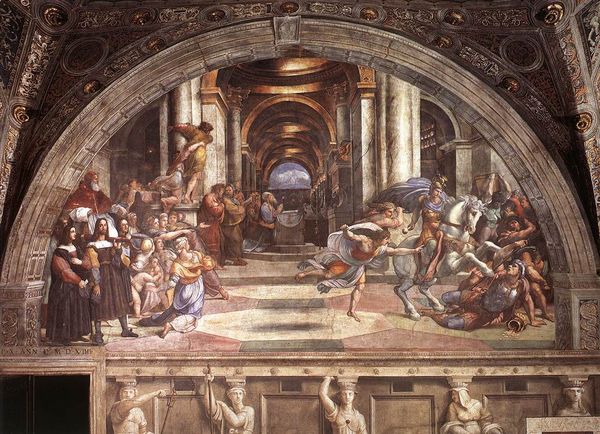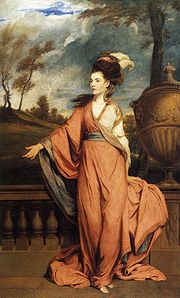
Grand manner
Encyclopedia


Classicism
Classicism, in the arts, refers generally to a high regard for classical antiquity, as setting standards for taste which the classicists seek to emulate. The art of classicism typically seeks to be formal and restrained: of the Discobolus Sir Kenneth Clark observed, "if we object to his restraint...
, and the modern "classic art" of the High Renaissance
High Renaissance
The expression High Renaissance, in art history, is a periodizing convention used to denote the apogee of the visual arts in the Italian Renaissance...
. In the eighteenth century, British
United Kingdom
The United Kingdom of Great Britain and Northern IrelandIn the United Kingdom and Dependencies, other languages have been officially recognised as legitimate autochthonous languages under the European Charter for Regional or Minority Languages...
artists and connoisseurs used the term to describe paintings that incorporated visual metaphors in order to suggest noble qualities. It was Sir Joshua Reynolds
Joshua Reynolds
Sir Joshua Reynolds RA FRS FRSA was an influential 18th-century English painter, specialising in portraits and promoting the "Grand Style" in painting which depended on idealization of the imperfect. He was one of the founders and first President of the Royal Academy...
who gave currency to the term through his Discourses on Art, a series of lectures presented at the Royal Academy
Royal Academy
The Royal Academy of Arts is an art institution based in Burlington House on Piccadilly, London. The Royal Academy of Arts has a unique position in being an independent, privately funded institution led by eminent artists and architects whose purpose is to promote the creation, enjoyment and...
from 1769 to 1790, in which he contended that painters should perceive their subjects through generalization and idealization, rather than by the careful copy of nature. Reynolds never actually uses the phrase, referring instead to the "great style" or "grand style", in reference to history painting
History painting
History painting is a genre in painting defined by subject matter rather than an artistic style, depicting a moment in a narrative story, rather than a static subject such as a portrait...
:
How much the great style exacts from its professors to conceive and represent their subjects in a poetical manner, not confined to mere matter of fact, may be seen in the cartoons of RaffaelleRaphael CartoonsThe Raphael Cartoons are seven large cartoons for tapestries, now in the Victoria and Albert Museum, London, painted by the High Renaissance painter Raphael in 1515-16 and showing scenes from the Gospels and Acts of the Apostles...
. In all the pictures in which the painter has represented the apostles, he has drawn them with great nobleness; he has given them as much dignity as the human figure is capable of receiving yet we are expressly told in Scripture they had no such respectable appearance; and of St. Paul in particular, we are told by himself, that his bodily presence was mean. Alexander is said to have been of a low stature: a painter ought not so to represent him. Agesilaus was low, lame, and of a mean appearance. None of these defects ought to appear in a piece of which he is the hero. In conformity to custom, I call this part of the art history painting; it ought to be called poetical, as in reality it is.
Originally applied to history painting, regarded as the highest in the hierarchy of genres
Hierarchy of genres
A hierarchy of genres is any formalization which ranks different genres in an art form in terms of their prestige and cultural value....
, the Grand Manner came thereafter also to be applied to portrait painting
Portrait painting
Portrait painting is a genre in painting, where the intent is to depict the visual appearance of the subject. Beside human beings, animals, pets and even inanimate objects can be chosen as the subject for a portrait...
, with sitters depicted life size and full-length, in surroundings that conveyed the nobility and elite status of the subjects. Common metaphors included the introduction of classical architecture, signifying cultivation and sophistication, and pastoral backgrounds, which implied unpretentious sincerity (and large estates).
If Roman
Ancient Rome
Ancient Rome was a thriving civilization that grew on the Italian Peninsula as early as the 8th century BC. Located along the Mediterranean Sea and centered on the city of Rome, it expanded to one of the largest empires in the ancient world....
sculpture
Sculpture
Sculpture is three-dimensional artwork created by shaping or combining hard materials—typically stone such as marble—or metal, glass, or wood. Softer materials can also be used, such as clay, textiles, plastics, polymers and softer metals...
and Italian Renaissance
Italian Renaissance
The Italian Renaissance began the opening phase of the Renaissance, a period of great cultural change and achievement in Europe that spanned the period from the end of the 13th century to about 1600, marking the transition between Medieval and Early Modern Europe...
painting
Painting
Painting is the practice of applying paint, pigment, color or other medium to a surface . The application of the medium is commonly applied to the base with a brush but other objects can be used. In art, the term painting describes both the act and the result of the action. However, painting is...
provided the gestures for the genre
Genre
Genre , Greek: genos, γένος) is the term for any category of literature or other forms of art or culture, e.g. music, and in general, any type of discourse, whether written or spoken, audial or visual, based on some set of stylistic criteria. Genres are formed by conventions that change over time...
, it was the court portraiture of Peter Paul Rubens and Anthony van Dyck
Anthony van Dyck
Sir Anthony van Dyck was a Flemish Baroque artist who became the leading court painter in England. He is most famous for his portraits of Charles I of England and his family and court, painted with a relaxed elegance that was to be the dominant influence on English portrait-painting for the next...
that came to exemplify the urbane portrait style practised by Reynolds, Thomas Gainsborough
Thomas Gainsborough
Thomas Gainsborough was an English portrait and landscape painter.-Suffolk:Thomas Gainsborough was born in Sudbury, Suffolk. He was the youngest son of John Gainsborough, a weaver and maker of woolen goods. At the age of thirteen he impressed his father with his penciling skills so that he let...
, and Pompeo Batoni
Pompeo Batoni
Pompeo Girolamo Batoni was an Italian painter whose style incorporated elements of the French Rococo, Bolognese classicism, and nascent Neoclassicism.-Biography:He was born in Lucca, the son of a goldsmith, Paolino Batoni...
, and then in the nineteenth and twentieth centuries by Sir Thomas Lawrence
Thomas Lawrence
Thomas Lawrence may refer to:*Sir Thomas Lawrence, British artist, President of Royal Academy*Thomas Lawrence , mayor of colonial Philadelphia*T. E. Lawrence, "Lawrence of Arabia"*Thomas Lawrence , U.S. politician...
, John Singer Sargent
John Singer Sargent
John Singer Sargent was an American artist, considered the "leading portrait painter of his generation" for his evocations of Edwardian era luxury. During his career, he created roughly 900 oil paintings and more than 2,000 watercolors, as well as countless sketches and charcoal drawings...
and Augustus John
Augustus John
Augustus Edwin John OM, RA, was a Welsh painter, draughtsman, and etcher. For a short time around 1910, he was an important exponent of Post-Impressionism in the United Kingdom....
. In the late nineteenth century the rhetoric of the Grand Manner was adopted not only by the nouveaux riches, but by ambitious middle class sitters as well. When especially ostentatious in presentation, typically in full-length works, this has also been referred to as the swagger portrait.

